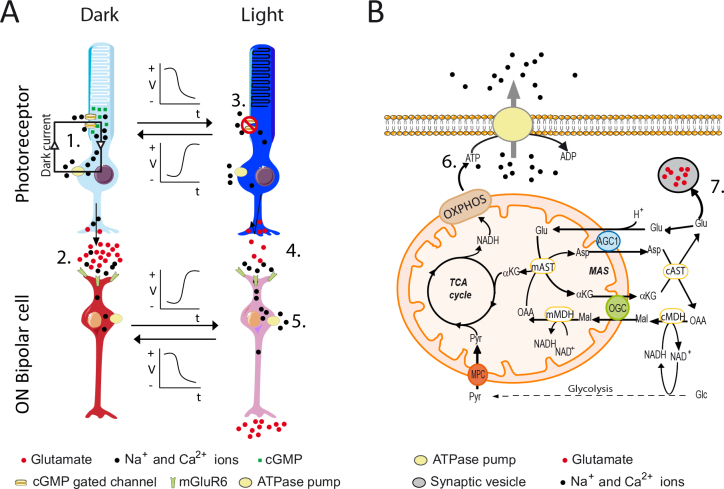Figure 1.
Metabolic requirements of the retina. A: In darkness, the elevated concentration of cGMP keeps the Na+ and Ca2+ channels open, and the Na+ inflow is counterbalanced by Na+/K+ pumps with high ATP expenditure to maintain the dark current (1). The photoreceptor is depolarized (light blue) and releases glutamate (2), which needs to be actively sequestered back and protected from oxidation. Light activates the phototransduction cascade decreasing cGMP levels, which closes the Na+ and Ca2+ channel, reduces the dark current and ATP demand (3), and hyperpolarizes the photoreceptor (dark blue), decreasing glutamate release (4). In the darkness, the high glutamate level in the synapse keeps the ON bipolar cells polarized (dark red), whereas after light the ON bipolar cells become depolarized (light red) and will increase their energy requirement to fuel the ion pumps (5). B: Role of aralar in retinal metabolism. Aralar, as part of the malate-aspartate shuttle (MAS), is required for efficient ATP generation by glucose oxidative metabolism. The ATP (6) generated is necessary to fuel the ion pumps of the photoreceptors (dark) and the ON bipolar cells (light). Aralar also participates in the protection of glutamate from oxidation to serve as a neurotransmitter by photoreceptors (7). αKG, α-ketoglutarate; AGC1, aspartate-glutamate carrier; Asp, aspartate; AST, aspartate transaminase; Glc, glucose; Glu, glutamate; Mal, malate, MDH, malate dehydrogenase; OAA oxaloacetate; OGC, oxoglutarate carrier; OXPHOS, oxidative phosphorylation; Pyr, pyruvate; TCA, tricarboxylic acid.

